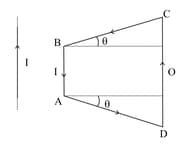Embibe Experts Solutions for Chapter: Moving Charges and Magnetism, Exercise 1: Exercise
Embibe Experts Physics Solutions for Exercise - Embibe Experts Solutions for Chapter: Moving Charges and Magnetism, Exercise 1: Exercise
Attempt the practice questions on Chapter 4: Moving Charges and Magnetism, Exercise 1: Exercise with hints and solutions to strengthen your understanding. Achieve CUET (UG) Physics Practice Book solutions are prepared by Experienced Embibe Experts.
Questions from Embibe Experts Solutions for Chapter: Moving Charges and Magnetism, Exercise 1: Exercise with Hints & Solutions
A particle of specific charge (q/m) is projected from the origin of coordinates with initial velocity [ui-vj]. Uniform electric magnetic fields exist in the region along the +y direction, of magnitude E and B. The particle will definitely return to the origin once if
According to Bio-Savart law states that the magnetic field due to the current element:
Assertion: Ampere's circuital law holds for steady currents which do not fluctuate with time.
Reason: Ampere's circuital law is similar to that of Biot-Savart law.
A toroid has turns per unit length. If it carries a current of , the magnetic energy density inside the toroid is
When the number of turns in a toroidal coil is doubled, then the value of magnetic flux density will becomes
Two long parallel wires separated by a distance have equal currents flowing in each. Either wire experiences a magnetic force . If the distance is increased to and current in each wire is reduced to , the force between them will now be -
Loop and long straight wire are in the same plane. Side . Distance between long straight wire and is equal to the distance between and . Net force on the loop is

A galvanometer has a coil of resistance and requires for full-scale deflection. The shunt resistance needed to convert the galvanometer into an ammeter of the range is
